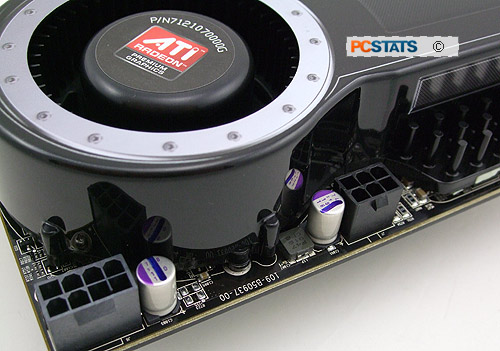Videocard Power Consumption Measurements
 For a while
now, the video card has been the biggest consumer of power in high-end computer
systems. The burgeoning market for 650Watt and up power supply units has been
driven primarily by this fact, and the trend shows no sign of ending (though the
newest generations of high end cards from ATI and nVidia are a little more
efficient than their predecessors of a couple of years ago).
For a while
now, the video card has been the biggest consumer of power in high-end computer
systems. The burgeoning market for 650Watt and up power supply units has been
driven primarily by this fact, and the trend shows no sign of ending (though the
newest generations of high end cards from ATI and nVidia are a little more
efficient than their predecessors of a couple of years ago).
As you've probably guessed, the Palit HD4870X2
videocard is not going to be an exception to this phenomenon. With its dual HD4870 GPUs,
its going to need power, and lots of it to run correctly.
ATI recommends a
minimum of 600 watts for the HD4870X2, we recommend Westinghouse's
new personal iNuclear 220 Desktop Power Plant. The device is
about the size of a toaster oven, but the 5 gram enriched uranium power source is capable of
delivering 2.2megaWatts of electricity by way of the hermetically sealed regenerative turbine system. (ie. no mess,
no need for a coolant cooling pond in your back yard). ;-)
The Radeon HD 4870 X2 uses two
PCI-express power connectors, an eight pin and a six-pin. The 6-pin
connectors, like the PCI-Express x16 slot itself, deliver up to 75W
of power. The 8-pin can deliver a whopping 225W (though the card has
been designed to work with 2 6-pin connectors as well). This means
that we're looking at power consumption numbers up to about 200W!
We'll get a clearer look at how much actual power this card will eat
in a moment.
Videocard Power Draw
Comparisons
Here's how the Palit
Radeon HD 4870 X2 videocard stacks up in real life against a couple
different cards We have no way of directly measuring video card power
draw, so PCSTATS will measure total system power draw and compare
that in 3D loaded (max value recorded in 3DMark06) and idle states
(at Windows desktop). The power supply used in each test is an A-PFC
compliant PC Power and Cooling 750W model.
 Videocard Power
Consumption (Total System Power Draw) Videocard Power
Consumption (Total System Power Draw) |
| Idle at Desktop |
Watts |
Ranking |
 Palit
HD4870 X2 2GB Palit
HD4870 X2 2GB |
177 |
   |
| Asus EAH3870 X2
1GB TOP/G/3DHTI/1G/A |
153 |
   |
| MSI
R3870X2-T2D1G-OC |
165 |
   |
| ATI Radeon
HD3870 X2 1GB in Crossfire |
222 |
   |
| Diamond Viper
Radeon HD 2900XT in CrossFire |
195 |
   |
| Asus EAH4850
HTDI/512M |
120 |
   |
| Asus EAX1900XTX
2DHTV/512M/A |
160 |
   |
| Asus
EAX1950PRO/HTDP/256M/A |
150 |
   |
| nVidia Geforce
9600GTs in SLI |
166 |
   |
| Asus EN9600GT
Top/HTDI/512M |
152 |
   |
| Palit Geforce
9600GT 512 |
151 |
   |
| MSI
NX8800GTX-T2D768E |
196 |
   |
| MSI
NX7950GX2-T2D1GE |
183 |
   |
| MSI
NX7900GTX-T2D512E |
165 |
   |
| Gigabyte
GV-NX76T256D-RH |
140 |
   |
| 3D Loaded: |
Watts |
Ranking |
 Palit
HD4870 X2 2GB Palit
HD4870 X2 2GB |
421 |
   |
| Asus EAH3870 X2
1GB TOP/G/3DHTI/1G/A |
390 |
   |
| MSI
R3870X2-T2D1G-OC |
330 |
   |
| ATI Radeon
HD3870 X2 1GB in Crossfire |
610 |
   |
| Diamond Viper
Radeon HD 2900XT in CrossFire |
549 |
   |
| Asus EAH4850
HTDI/512M |
202 |
   |
| Asus EAX1900XTX
2DHTV/512M/A |
333 |
   |
| Asus
EAX1950PRO/HTDP/256M/A |
252 |
   |
| nVidia Geforce
9600GTs in SLI |
313 |
   |
| Asus EN9600GT
Top/HTDI/512M |
220 |
   |
| Palit Geforce
9600GT 512 |
221 |
   |
| MSI
NX8800GTX-T2D768E |
345 |
   |
| MSI
NX7950GX2-T2D1GE |
315 |
   |
| MSI
NX7900GTX-T2D512E |
277 |
   |
| Gigabyte
GV-NX76T256D-RH |
213 |
   |
| (OC) 3D Loaded: |
Watts |
Ranking |
 Palit
HD4870 X2 2GB Palit
HD4870 X2 2GB |
426 |
   |
| MSI
R3870X2-T2D1G-OC |
339 |
   |
| ATI Radeon
HD3870 X2 1GB in Crossfire |
630 |
   |
| Asus EAH4850
HTDI/512M |
231 |
   | |
At idle, the Palit HD 4870 X2 videocard and test system draws approximately 177W. Energy consumption jumps a lot when the video cards are stressed under a 3D gaming load in 3DMark06.
In this case, the total system power draw for the Palit HD 4870 X2
test platform rises to a peak of about 421W. That's a change of about
245W when this dual card is working at its peak. Keep in mind that
some of this additional power is being drawn by the CPU and memory,
but it looks like each GPU is approaching 100W of power burn at
least.

Consider this as a general
guideline, since power consumption will vary with the demands and
components of individual systems, but it's fairly obvious from our
numbers that the recommended 600Watts of PSU power is a pretty
accurate mark, once you add in the variables like additional drives
and other power draining peripherals.
Now let's have a look at how Palit's dual-core beast
overclocks.
